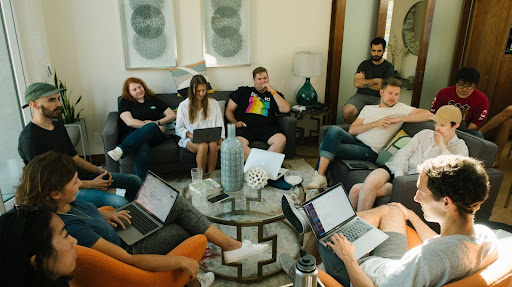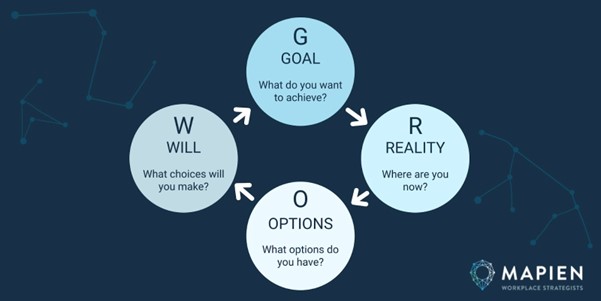
Applying the GROW Coaching Model to Move Through Challenges
This is blog #3 in our series on coaching models. Sign up to our mailing list to make sure you don’t miss out on our future content.
Got a challenge you need to work through or set a big goal you haven’t achieved yet? Wondering how you can get from where you are now to where you need to be — while confidently leading your team to the other side?
Perhaps you’re dealing with major industry or technology changes (most CEOs would agree that AI is a big one right now). You might need to lead your team through a restructure, relocation, acquisition, or merger. You may even find yourself experiencing unexpected challenges like natural disasters, supply chain issues, or global events.
Whether you’re currently facing a challenge or simply want to be better prepared for the future, the GROW Coaching Model is a great addition to your toolkit. In this blog, you’ll learn how you can apply this framework to your own situation – and how you might use it to support others.
Introducing the GROW Model

The GROW Coaching Model is a framework with four distinct steps that form the acronym: Goals, Reality, Options, and Will.
This simple-but-effective model can be used to encourage healthy conversations that are focused on solutions. You can apply the framework in team meetings, project planning, coaching sessions, leadership development, and more. It can help you build confidence, overcome difficulties, navigate change, and work towards goals.
So, let’s break each step down a little further…
1. Goal: What Do You Want to Achieve?
The first part of the framework involves identifying your aspirational goals and desired outcomes. Starting here will help you shift the focus of the conversation from problems to solutions.
Useful prompts for identifying goals include:
- What are you trying to achieve?
- What does success look or feel like?
- What would you like to happen that is not happening now?
- What is important about this?
- How will you know when you have achieved your goal?
If you’re not sure what challenges or goals to focus on (and you’re feeling stressed or under pressure), you might like to check out our previous blog on How Leaders Can Apply the Circles of Control, Influence & Concern. This coaching model can be useful for figuring out which challenges you should tackle first.
2. Reality: Where Are You Now?
Once you’ve established some meaningful goals, it’s time for a reality check. You need to consider your current situation, any obstacles that might come up, and what resources you have available to help you achieve your goals.
Prompts that will help you identify your reality include:
- What is happening at the moment?
- When and how often does this happen?
- What impact does this have on you?
- What progress have you made so far?
- What is working well right now?
By the way, if it feels like you’re facing a lot of obstacles right now, it’s not just you. A recent survey of CEOs revealed mixed feelings about performance over the coming 12 months compared to the start of 2023, thanks to obstacles like the increasing cost of doing business, rising capital costs, and geopolitical tensions.
3. Options: What Options Do You Have?
Next, it’s time to consider all the options and opportunities that may help you get closer to your goal. At this stage, don’t worry about getting it perfect. Take a ‘quantity over quality’ mindset to help broaden your thinking, encourage creativity, and generate a variety of ideas. There are many possible pathways to success — challenge yourself to identify as many as you can!
Some questions that can help you explore your options include:
- What are your options?
- What approaches or actions have been used under similar circumstances?
- What has worked in the past?
- What could you do differently?
- What are the benefits and pitfalls of these options?
If you or your team feel tired, stuck, or negative after brainstorming some options, it might be a good idea to pause and take a break. Research shows that broad thinking and creative problem solving works best when people are in a positive mindset. So, it’s okay to take a coffee break or (if time allows) come back and finish step four the following day.
4. Will: What Choices Will You Make?
The final part of the GROW Coaching Model involves deciding which specific, short-term actions will be beneficial to help you move forward. You don’t have to plan out all your steps. Instead, focus on what you can do now to clear some blocks, boost your motivation, and build momentum towards your goal.
These prompts will help you determine what to do next:
- What do you want to do?
- What one small step are you going to take now?
- When will you do that?
- What might get in the way?
- How will you know you have been successful?
Studies show that the level of accountability in organisations positively and significantly impacts performance. Meanwhile, individual accountability predicts higher levels of task and challenge performance. So, in addition to defining your next steps, we also recommend scheduling timeframes, setting accountability measures, and organising check-ins to encourage ownership.
If you’re not sure where to start with your to-do list, check out our previous blog: Get Priorities Straight With Covey’s Time Management Matrix.
Tips for Applying the GROW Model
These extra tips will help you get the most out of this coaching model.
Write Down Your Goals
When writing out your goals, it’s a good idea to note your answers down on paper. Written goals reduce the risk of ‘shifting goalposts’ – and ensures you have something specific you’re working towards, even as you go through periods of intense change. And when you do achieve your written goal, you’ll get the feelings of pride and fulfilment that come with completing a task – which can help build momentum and motivation for your next big goal.
Be the Facilitator
If you’re using the GROW Model to coach others or lead a team, you should assume the role of a facilitator. This means you’ll need to focus on active listening instead of offering direct advice. Ask questions that will help participant(s) identify information and ideas within each part of the framework. Then guide them through the process to select and implement the options they believe to be best.
Go Back If You Need To
Finally, what many people don’t realise is that the GROW Coaching Framework doesn’t have to be linear. You can go back to earlier steps in the sequence and even repeat the process in order to deepen your understanding. This might involve refining your goals, adding more insights about your current situation, or exploring more options in order to move forward more easily.
Examples of the GROW Coaching Model
Not sure how you might apply the GROW Coaching Model? We’ve put together a few examples that show how you could use this framework to explore a specific goal and confidently move forward. Like the below examples, you might write down notes as you work through the four steps, or you might use the framework to guide your team’s conversations towards a solution.
Example 1: A Business That Needs to Expand

Goal:
We want to expand the business into a new market and location. This will drive revenue growth and help us work towards our bigger mission of reaching people all over Australia.
Reality:
Right now, we’re only operating one storefront in our local market. This limits our growth. We’ve started to conduct market research to determine where we should go next. We don’t have a lot of capital, so we need to make sure that anything we invest in will pay for itself quickly.
Options:
- We could open a new store in another state or major city.
- We could offer to buy a competitor business in an area we want to target.
- We could look into expanding our products/services at our existing location to grow the business without opening a new location.
- We could partner with other businesses to offer our products/services in different markets without having to open our own premises.
- We could promote our online options heavily in potential new markets to test the waters first.
Will:
The first step is to research each option further. We’ll do some rough projections, costs, and timelines. Then we’ll consult with various business advisors to develop the pros and cons, with the view of making a decision by the end of the year.
Example 2: A Business That Needs to Improve Sustainability

Goal:
We want to improve environmental sustainability in the business. We know that sustainability is an important responsible business practice — and matters to both staff and customers.
Reality:
While we’ve already implemented some initiatives, we could do a lot better. We’ve gone totally paperless by embracing digital recordkeeping and our energy supplier is carbon neutral. But most of our staff members drive cars to work (and to coffee/lunch), which increases our carbon footprint. Local public transport options are limited. We’re unclear on how sustainable some of our suppliers are.
Options:
- We could start a car-pooling initiative.
- We could hire or buy our own bus that drives staff to work.
- We could lobby the government to provide more public transport.
- We could encourage staff to take more work-from-home days.
- We could cater lunch in the office some days to reduce car trips.
- We could provide good quality, compostable coffee pods and reusable mugs in the breakroom.
- We could ask our suppliers to share information on their sustainability measures.
- We could switch to new suppliers that have better track records with sustainability practices.
Will:
The first step is to consult with our team to see if they have any more ideas about sustainability. We’ll also research each option further so we have clearly defined facts that back up whether an option is feasible and whether it would genuinely improve sustainability. We want to make at least some improvements to our transport-related carbon footprint and supplier choices by the end of the year.
Example 3: A Business That Needs to Get Paid on Time

Goal:
We want to eliminate our unpaid invoices or late payments because they have a negative impact on our business and staff.
Reality:
Over the last year, 43% of our invoices were paid late and 1% were written off. This impacts our cash flow and ability to hire new team members, which increases stress for existing staff and makes it hard to deliver services on time. Some of our customers are feeling the impacts of the economy and although costs have gone up, our customers’ budgets have not. This could be contributing to slow payments.
Options:
- We could require all invoices to be paid upfront.
- We could offer payment plans to help customers stick to their budget.
- We could offer a longer payment period on invoices.
- We could update our accounting system to offer more payment methods.
- We could implement an automatic reminder system.
- We could refer some invoices to a collections agency.
- We could reposition our services to attract a different market that is more likely to pay on time.
- We could communicate with customers to expect longer timeframes for our services.
- We could introduce a late payment fee or early payment rewards to incentivise customers to pay on time.
- We could ask the bank for a loan to help us hire new staff without having to wait for the cash flow to catch up.
Will:
We’ll start by immediately setting up a meeting with our accounting and finance team to discuss the options further and find out what solutions they can recommend and implement. We will interview some of our customers to check our assumptions about why they might be paying late. We will engage a consultant who has expertise in the area, as well as chat to the bank to find out what’s possible. We’ll decide which strategy is our lowest hanging fruit and implement this by the end of the month so we can start seeing our unpaid invoice as soon as possible.
Start Applying the GROW Model Today
“Moving forward is easier if you know where you are and where you can go”.
You can use the GROW Model to support yourself, your employees, and your teams to boost performance, learn new skills, solve problems, and make better decisions. By asking targeted questions, you can go from goal setting, to planning a way forward and achieving your goals.
Whether you’re keen to have a productive conversation with the team, work with a leadership coach, or coach yourself through a challenge… this four-step framework can help you find a way to move forward.
We’d encourage you to give the GROW Coaching Model a try today!
Connect with us
Looking for leadership coaching or hands-on help with more great tools like this one? Contact us today!

